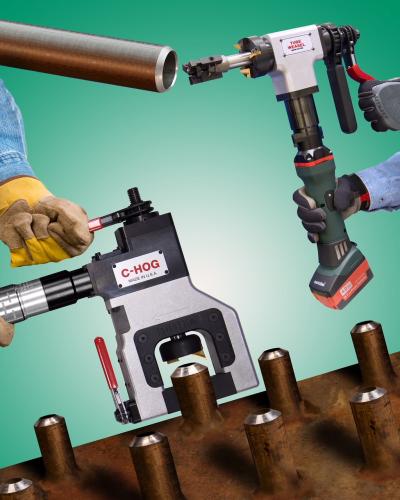
Two alternative portable pipe milling tools for performing welding end preps on pipe and tube from 0.5” I.D. to 3” O.D. with different bores and wall thicknesses are available from Esco Tool.
MILLHOG Pipe Beveling Tools for pipe and tube from 0.5” I.D. to 3” O.D. work well on all hard alloys without cutting fluids and can bevel, face and bore simultaneously. For applications from 0.75” I.D., the Tube Weasel right angle I.D. clamping tool is self-centering and fits a Dutchman 2.75” W and for applications with small bore heavy wall tube and pipe, the C-HOG rigidly clamps on the O.D. allowing the use of larger I.D. boring blades.
Available with pneumatic, electric or battery power, Tube Weasel MILLHOG and C-Hog MILLHOG tools provide rigid mounting with internal and external clamping surfaces, respectively, and torque-free operation. Both tools feature robust construction and utilize cutter blades with radical chip breakers that transfer heat away from the surface. Standard blades are TiN coated and a hard lube version is offered for enhanced heat resistance.
Contact Details
Related Glossary Terms
- alloys
alloys
Substances having metallic properties and being composed of two or more chemical elements of which at least one is a metal.
- boring
boring
Enlarging a hole that already has been drilled or cored. Generally, it is an operation of truing the previously drilled hole with a single-point, lathe-type tool. Boring is essentially internal turning, in that usually a single-point cutting tool forms the internal shape. Some tools are available with two cutting edges to balance cutting forces.
- gang cutting ( milling)
gang cutting ( milling)
Machining with several cutters mounted on a single arbor, generally for simultaneous cutting.
- milling
milling
Machining operation in which metal or other material is removed by applying power to a rotating cutter. In vertical milling, the cutting tool is mounted vertically on the spindle. In horizontal milling, the cutting tool is mounted horizontally, either directly on the spindle or on an arbor. Horizontal milling is further broken down into conventional milling, where the cutter rotates opposite the direction of feed, or “up” into the workpiece; and climb milling, where the cutter rotates in the direction of feed, or “down” into the workpiece. Milling operations include plane or surface milling, endmilling, facemilling, angle milling, form milling and profiling.
- titanium nitride ( TiN)
titanium nitride ( TiN)
Added to titanium-carbide tooling to permit machining of hard metals at high speeds. Also used as a tool coating. See coated tools.
